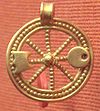|
IcovellaunaIcovellauna was a Celtic goddess worshiped in Gaul. Her places of worship included an octagonal temple at Le Sablon in Metz, originally built over a spring,[1] from which five inscriptions dedicated to her have been recovered,[2] and Trier, where Icovellauna was honored in an inscription in the Altbachtal temple complex.[3][4][A] Both of these places lie in the valley of the river Moselle of eastern Gaul in what are now Lorraine in France and Rhineland-Palatinate in Germany. One such inscription was, somewhat unusually, inscribed on a copper tablet in Roman cursive letters.[5] At the temple in Metz, a spiral staircase led down to the water level, allowing worshipers to leave offerings in the spring and/or to take the waters. A statuette of a local Gaulish Mercury was among the ex-votos deposited at the shrine,[1][6] which also included coins and ceramics dating from the 2nd to 4th centuries CE.[7] Jeanne-Marie Demarolle states that Apollo was also associated with Icovellauna.[8] Demarolle glosses the name Icovellauna as bonne fontaine or "good fountain".[9] Miranda Green follows Joseph Vendryes in interpreting the Gaulish root ico- as "water" and characterizes Icovellauna as a "water goddess" who "presided over the nymphaeum at Sablon in the Moselle Basin, a thermal spring-site".[10] Xavier Delamarre, however, considers Vendryes' interpretation to be very improbable; on purely etymological grounds, he suggests that ico- might be the name of a bird, perhaps the woodpecker.[11] The root uellauno- has been variously interpreted, though the interpretation "chief, commander" has recently found favor;[12] see Vellaunus.
Notes^ A: Although Jufer and Luginbühl also report a number of inscriptions to Icovellauna at Malzéville,[13] it has been suggested that this is an error on their part and that the inscriptions in question belong at Le Sablon in Metz.[14] The Epigraphik-Datenbank Clauss/Slaby has no records of any inscriptions from Malzéville published in CIL or similar publications.[15] References
Works cited
|

